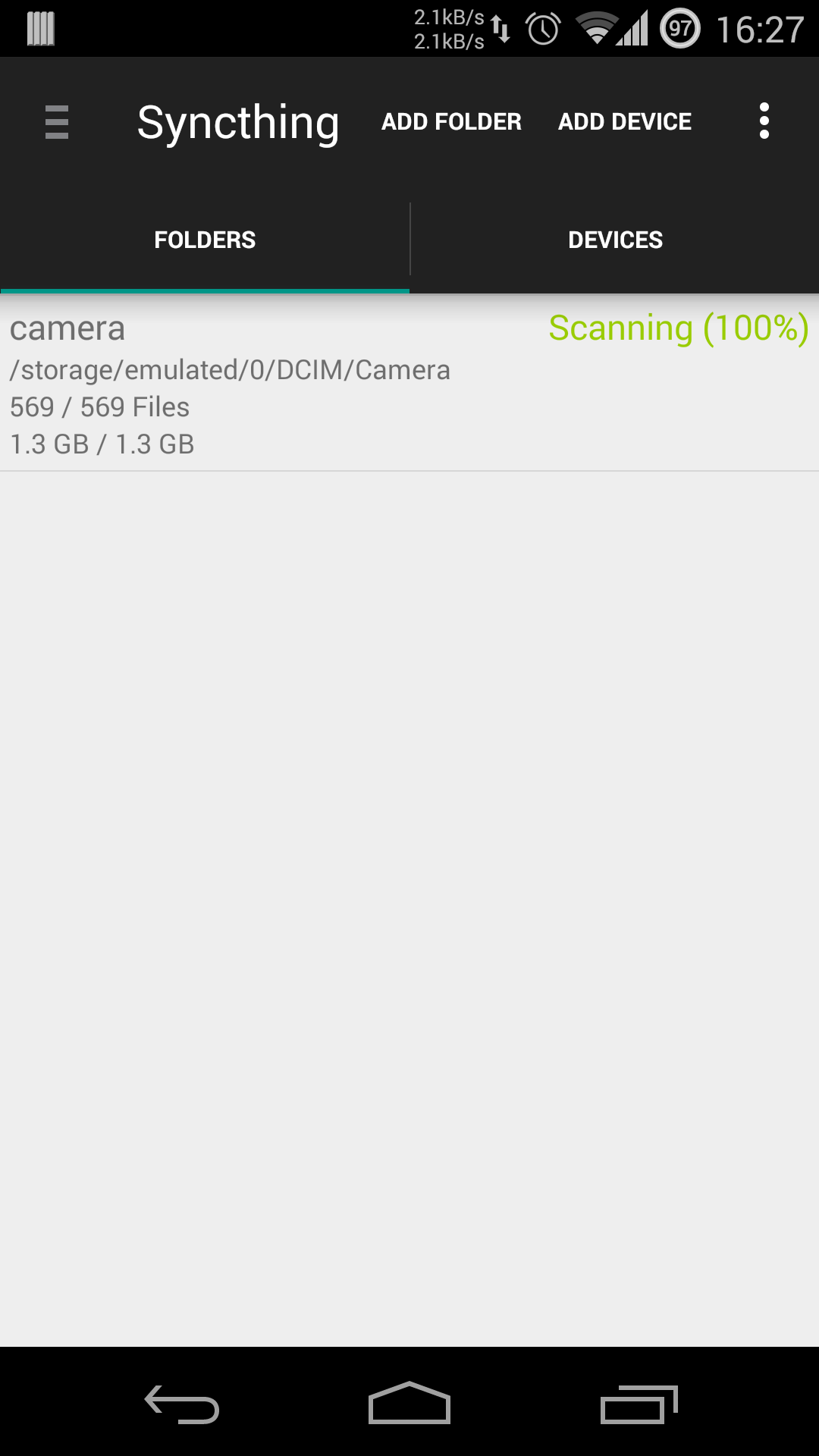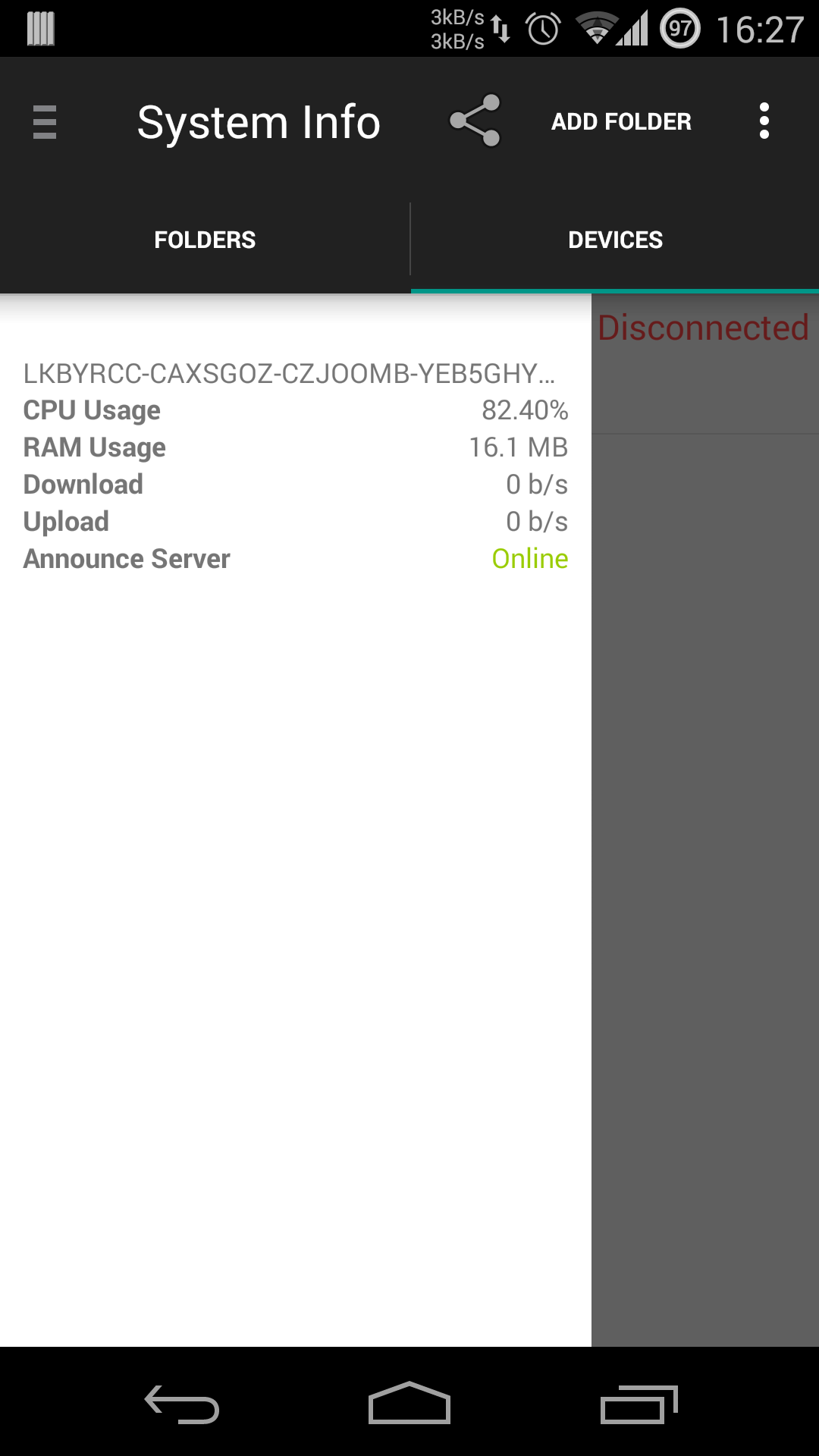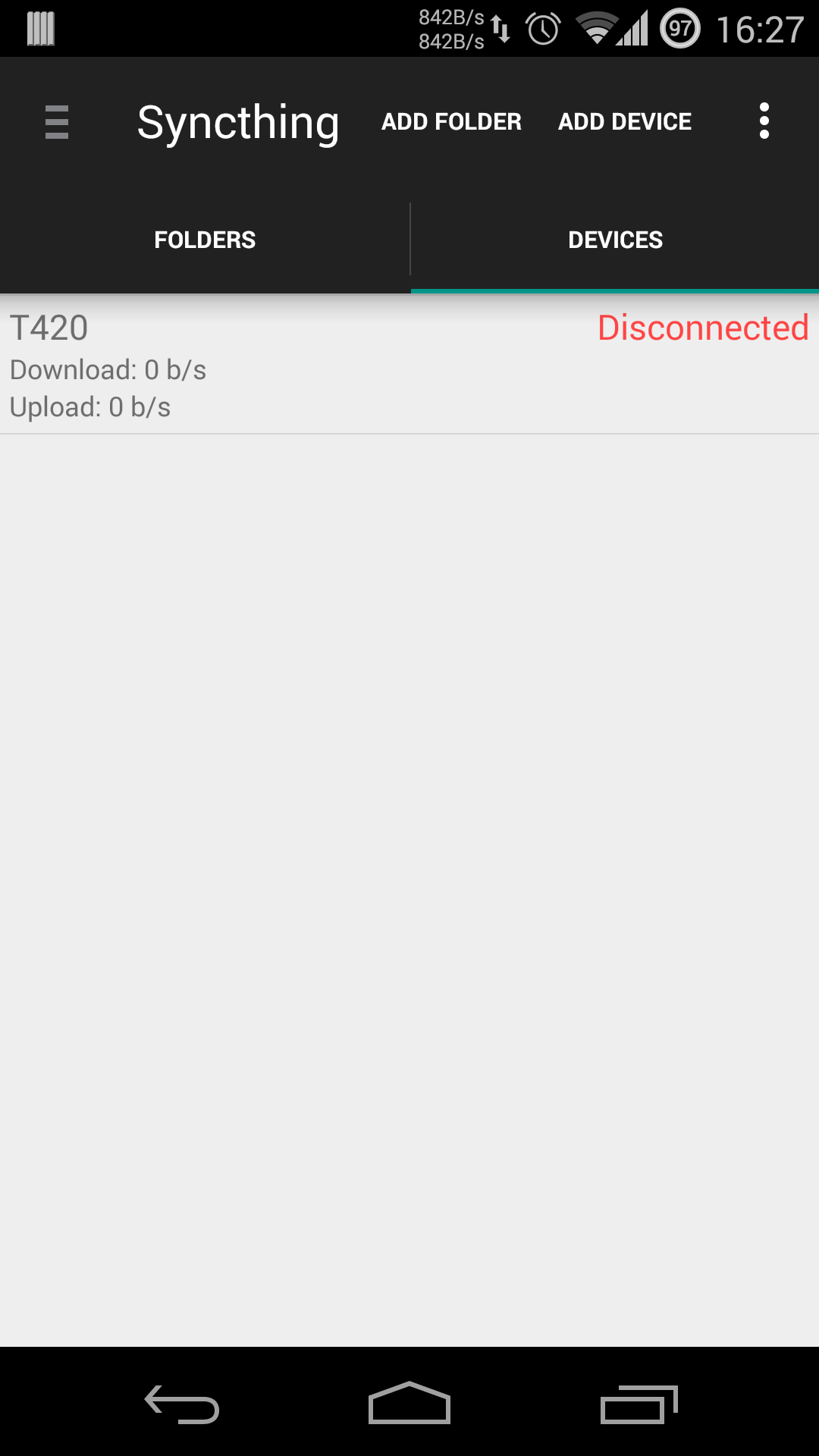# syncthing-android
[](https://travis-ci.org/syncthing/syncthing-android)
[](https://tip4commit.com/github/syncthing/syncthing-android)
A wrapper of [syncthing](https://github.com/syncthing/syncthing) for Android.


 [](https://play.google.com/store/apps/details?id=com.nutomic.syncthingandroid) [](https://f-droid.org/repository/browse/?fdid=com.nutomic.syncthingandroid)
# Translations
The project is translated on [Transifex](https://www.transifex.com/projects/p/syncthing-android/).
Translations can be updated using the [Transifex client](http://docs.transifex.com/developer/client/), using commands `tx push -s` and `tx pull -a`.
# Building
### Requirements
- Android SDK Platform (for the `compileSdkVersion` specified in [build.gradle](build.gradle))
- Android Support Repository
### Build instructions
Use `./gradlew assembleDebug` in the project directory to compile the APK.
To check for updated gradle dependencies, run `gradle dependencyUpdates`. Additionally, the git submodule in `ext/syncthing/src/github.com/syncthing/syncthing` may need to be updated.
### Getting Syncthing without building natively
To get Syncthing app for Android running on you device/emulator the native syncthing binary has to be available. There are multiple ways to get the native syncthing binary:
- open the Syncthing apk (the one taken from the play store) running on your device as a zip, extract the `lib/` folder into your project directory and rename it to `libs/`.
- Depending on your target architecture, download `syncthing-linux-386` or `syncthing-linux-armv5` from [syncthing releases](https://github.com/syncthing/syncthing/releases), and extract the binary to `libs/x86/libsyncthing.so` or `libs/armeabi/libsyncthing.so` respectively.
### Development Notes
It is recommended to change the GUI and Listen Address ports for the debug app, eg to 8081 and 22001 respectively.
The syncthing backend used for this android application provides a web interface by default. It can be accessed via the Settings menu -> 'Web GUI'. It is quite helpful to access this web interface from your development machine. Read [android documentation](http://developer.android.com/tools/devices/emulator.html#redirection) on how to access the network of your emulator. Or use the following steps to connect to the single currently running emulator/AVD.
- `telnet localhost 5554`
- `redir add tcp:18080:8080`
- Start syncthing app on your emulator and access the web interface from you favorite browser of your development machine via [http://127.0.0.1:18080](http://127.0.0.1:18080)
# License
The project is licensed under the [MPLv2](LICENSE).
[](https://play.google.com/store/apps/details?id=com.nutomic.syncthingandroid) [](https://f-droid.org/repository/browse/?fdid=com.nutomic.syncthingandroid)
# Translations
The project is translated on [Transifex](https://www.transifex.com/projects/p/syncthing-android/).
Translations can be updated using the [Transifex client](http://docs.transifex.com/developer/client/), using commands `tx push -s` and `tx pull -a`.
# Building
### Requirements
- Android SDK Platform (for the `compileSdkVersion` specified in [build.gradle](build.gradle))
- Android Support Repository
### Build instructions
Use `./gradlew assembleDebug` in the project directory to compile the APK.
To check for updated gradle dependencies, run `gradle dependencyUpdates`. Additionally, the git submodule in `ext/syncthing/src/github.com/syncthing/syncthing` may need to be updated.
### Getting Syncthing without building natively
To get Syncthing app for Android running on you device/emulator the native syncthing binary has to be available. There are multiple ways to get the native syncthing binary:
- open the Syncthing apk (the one taken from the play store) running on your device as a zip, extract the `lib/` folder into your project directory and rename it to `libs/`.
- Depending on your target architecture, download `syncthing-linux-386` or `syncthing-linux-armv5` from [syncthing releases](https://github.com/syncthing/syncthing/releases), and extract the binary to `libs/x86/libsyncthing.so` or `libs/armeabi/libsyncthing.so` respectively.
### Development Notes
It is recommended to change the GUI and Listen Address ports for the debug app, eg to 8081 and 22001 respectively.
The syncthing backend used for this android application provides a web interface by default. It can be accessed via the Settings menu -> 'Web GUI'. It is quite helpful to access this web interface from your development machine. Read [android documentation](http://developer.android.com/tools/devices/emulator.html#redirection) on how to access the network of your emulator. Or use the following steps to connect to the single currently running emulator/AVD.
- `telnet localhost 5554`
- `redir add tcp:18080:8080`
- Start syncthing app on your emulator and access the web interface from you favorite browser of your development machine via [http://127.0.0.1:18080](http://127.0.0.1:18080)
# License
The project is licensed under the [MPLv2](LICENSE).


 [](https://play.google.com/store/apps/details?id=com.nutomic.syncthingandroid) [](https://f-droid.org/repository/browse/?fdid=com.nutomic.syncthingandroid)
# Translations
The project is translated on [Transifex](https://www.transifex.com/projects/p/syncthing-android/).
Translations can be updated using the [Transifex client](http://docs.transifex.com/developer/client/), using commands `tx push -s` and `tx pull -a`.
# Building
### Requirements
- Android SDK Platform (for the `compileSdkVersion` specified in [build.gradle](build.gradle))
- Android Support Repository
### Build instructions
Use `./gradlew assembleDebug` in the project directory to compile the APK.
To check for updated gradle dependencies, run `gradle dependencyUpdates`. Additionally, the git submodule in `ext/syncthing/src/github.com/syncthing/syncthing` may need to be updated.
### Getting Syncthing without building natively
To get Syncthing app for Android running on you device/emulator the native syncthing binary has to be available. There are multiple ways to get the native syncthing binary:
- open the Syncthing apk (the one taken from the play store) running on your device as a zip, extract the `lib/` folder into your project directory and rename it to `libs/`.
- Depending on your target architecture, download `syncthing-linux-386` or `syncthing-linux-armv5` from [syncthing releases](https://github.com/syncthing/syncthing/releases), and extract the binary to `libs/x86/libsyncthing.so` or `libs/armeabi/libsyncthing.so` respectively.
### Development Notes
It is recommended to change the GUI and Listen Address ports for the debug app, eg to 8081 and 22001 respectively.
The syncthing backend used for this android application provides a web interface by default. It can be accessed via the Settings menu -> 'Web GUI'. It is quite helpful to access this web interface from your development machine. Read [android documentation](http://developer.android.com/tools/devices/emulator.html#redirection) on how to access the network of your emulator. Or use the following steps to connect to the single currently running emulator/AVD.
- `telnet localhost 5554`
- `redir add tcp:18080:8080`
- Start syncthing app on your emulator and access the web interface from you favorite browser of your development machine via [http://127.0.0.1:18080](http://127.0.0.1:18080)
# License
The project is licensed under the [MPLv2](LICENSE).
[](https://play.google.com/store/apps/details?id=com.nutomic.syncthingandroid) [](https://f-droid.org/repository/browse/?fdid=com.nutomic.syncthingandroid)
# Translations
The project is translated on [Transifex](https://www.transifex.com/projects/p/syncthing-android/).
Translations can be updated using the [Transifex client](http://docs.transifex.com/developer/client/), using commands `tx push -s` and `tx pull -a`.
# Building
### Requirements
- Android SDK Platform (for the `compileSdkVersion` specified in [build.gradle](build.gradle))
- Android Support Repository
### Build instructions
Use `./gradlew assembleDebug` in the project directory to compile the APK.
To check for updated gradle dependencies, run `gradle dependencyUpdates`. Additionally, the git submodule in `ext/syncthing/src/github.com/syncthing/syncthing` may need to be updated.
### Getting Syncthing without building natively
To get Syncthing app for Android running on you device/emulator the native syncthing binary has to be available. There are multiple ways to get the native syncthing binary:
- open the Syncthing apk (the one taken from the play store) running on your device as a zip, extract the `lib/` folder into your project directory and rename it to `libs/`.
- Depending on your target architecture, download `syncthing-linux-386` or `syncthing-linux-armv5` from [syncthing releases](https://github.com/syncthing/syncthing/releases), and extract the binary to `libs/x86/libsyncthing.so` or `libs/armeabi/libsyncthing.so` respectively.
### Development Notes
It is recommended to change the GUI and Listen Address ports for the debug app, eg to 8081 and 22001 respectively.
The syncthing backend used for this android application provides a web interface by default. It can be accessed via the Settings menu -> 'Web GUI'. It is quite helpful to access this web interface from your development machine. Read [android documentation](http://developer.android.com/tools/devices/emulator.html#redirection) on how to access the network of your emulator. Or use the following steps to connect to the single currently running emulator/AVD.
- `telnet localhost 5554`
- `redir add tcp:18080:8080`
- Start syncthing app on your emulator and access the web interface from you favorite browser of your development machine via [http://127.0.0.1:18080](http://127.0.0.1:18080)
# License
The project is licensed under the [MPLv2](LICENSE).